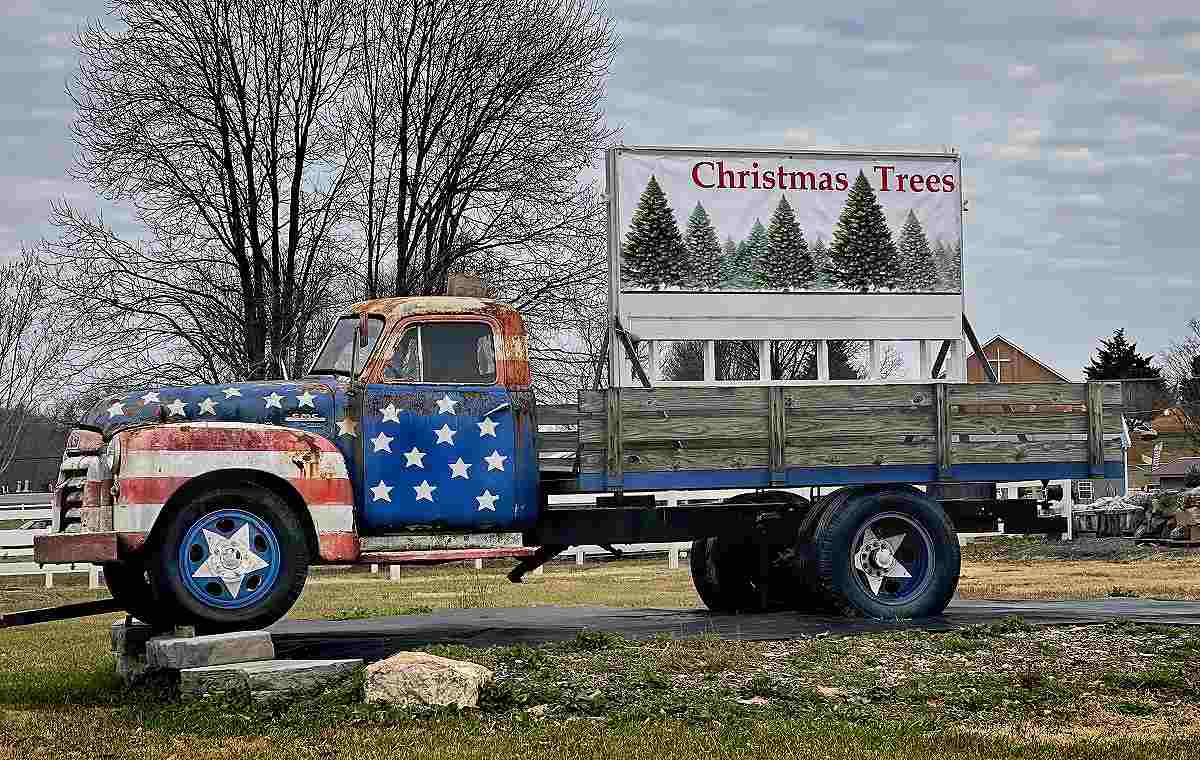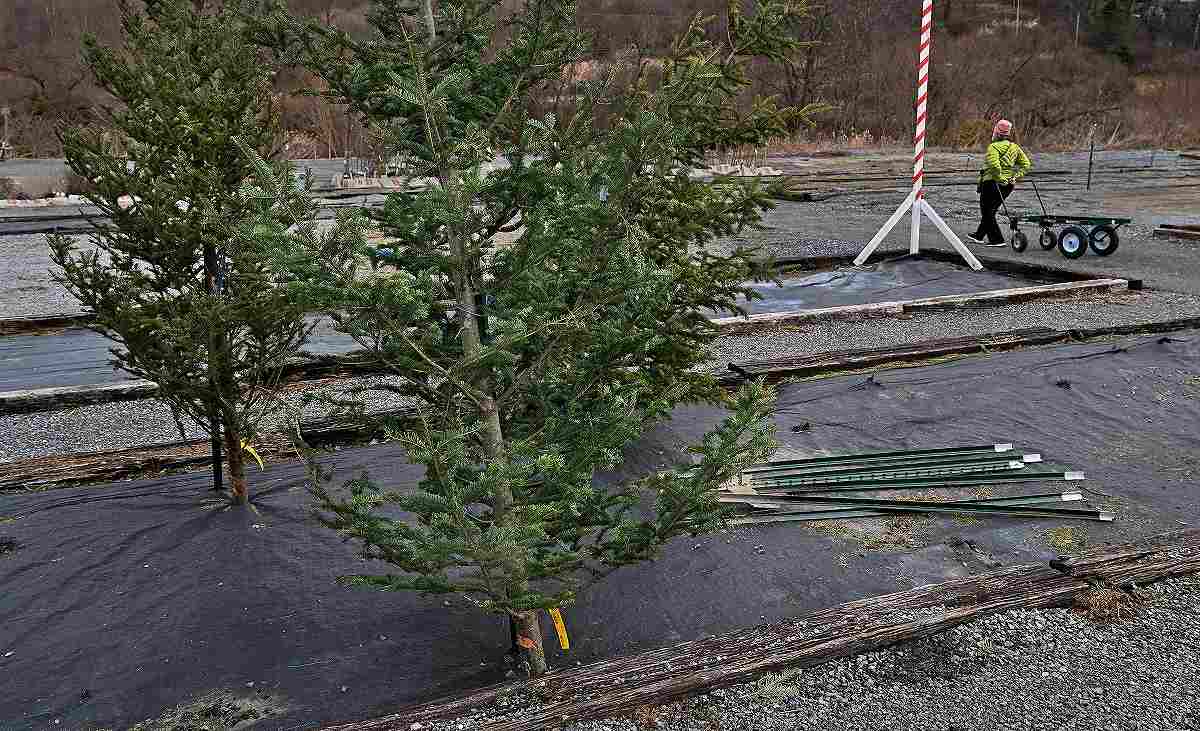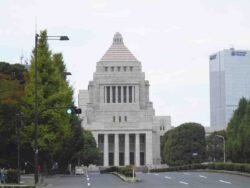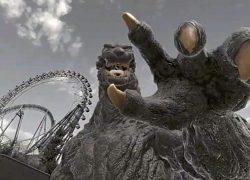
A vintage truck holds a sign featuring picturesque Christmas trees at Grey Goose Farm in Germantown, Maryland, on Dec. 21.
15:06 JST, December 23, 2023
Matt Rancourt knew what he was looking for.
The 38-year-old walked through a few Christmas tree lots in Washington last week before he found “the one” – a Fraser fir that stretched nine feet tall, with full branches and a classic triangular shape.
“It’s got to have that perfect balance,” he said. “I don’t really want any holes in the tree, and I think you kind of know when you know. It’s like a wedding dress.”
In the future, his annual search might not be so tedious, thanks to researchers at the North Carolina State University Christmas Tree Genetics Program who have spent decades developing what they call “elite” Christmas trees.
Let’s face it: Most Christmas trees have their flaws. Some are scraggly and balding. Some have unruly branches and jaunty angles. Others leave a headache-inducing mess of pine needles – and are too often targets of curiosity for overzealous felines.
Justin Whitehill, who leads the Christmas Tree Genetics Program, said the researchers’ goal is twofold: to breed Christmas trees so beautiful and hassle-free that they persuade faux-tree fanatics to convert to the real deal, and to help the growers who sustain a $2 billion industry.
“What we’re doing is using genetics to improve the Christmas trees’ traits to make the lives of consumers and growers better,” Whitehill said. “The focus is on three main traits: growth, needle retention and form. But we’re also working around sustainability and making trees more climate-resilient.”
Those traits are often on the minds of customers, said Robert Coulter, who has sold Christmas trees for Gheens Trees in D.C. and Maryland since 2013.
Shoppers frequently ask how long the trees will live, whether the branches will break and how fast the needles will fall off, he said.
“A lot of people actually when they come in, they’re like, ‘Oh, the needles are falling. We’d rather not have that. We’d rather get a fake tree,'” Coulter said.
Fraser firs are the most popular each season, he said, because customers want tall and wide trees that can fit more ornaments and lights. Those trees tend to sell quickly, Coulter said. Other customers will look for shorter trees to fit in smaller homes or apartments, or come in search of something with a stronger scent, such as a balsam fir.
“I just try to make sure people leave here with a good tree and a smile,” Coulter said.

With most of the nicer trees having been sold, Grey Goose Farm offers “Charlie Brown trees” at a discount.
Though the concept of gene modification on a Fraser fir might conjure images of scientists inside a lab, the process is more natural. “It’s the same idea as what humans have been doing over millennia, of taking certain traits and crossing them to eventually develop an organism that has that desired kind of look or aesthetic,” Whitehill said.
In other words: “The same process of how we get a Chihuahua from a wild wolf.”
The Christmas tree undertaking began in the late 1990s, when those involved with the N.C. State program began identifying the best Fraser firs in North Carolina. With its superior needle retention, conical form and sturdy branches, the Appalachian species is already considered the cream of the crop when it comes to Christmas trees – in fact, the tree jollying up the White House this year is an 18 1/2-foot Fraser fir from Fleetwood, N.C.
So how do you make the classic Christmas tree more perfect?
“We screened 30,000 wild trees originating from the highest peaks of the mountains in western North Carolina, then whittled it down to our best 25 out of 30,000,” Whitehill said. That sample of 25 lost the least amount of needles, showcased the densest foliage and had the fastest growth rate – trees that could be expected to lose just 1 percent of their needles after reaching a desirable height of six feet in about six to seven years.
To create the trees, the scientists used a technique called grafting, fusing together 1,000 roots from other trees with cuttings from the sample of 25 to ensure the elite Fraser fir genes are expressed at the top of the tree.
In 1999, the first generation of “perfect” Christmas trees began growing on a six-acre plot in Ashe County, N.C. Although 24 years have passed, the firs are not quite ready to hit the market.
“You have to think of Christmas trees like people,” Whitehill said. “They live for 80 to 100 years, or more. It takes them eight to 10 years, on average, to grow up to a harvestable height. And it takes them decades to be able to produce offspring. They won’t start producing cones until it gets to be between 20 to 25 years old.”
In practical terms, that means cones from the juiced-up Christmas trees won’t be picked up and cleaned until the 2026 fall season, Whitehill said. Growers will then be able to begin planting their seeds around February of the next year – which will be followed by one year of growth inside a greenhouse and then six to seven years in a field while they reach prime height.
“So I’m hoping that by 2036, Christmas trees developed in our program are going to be available to consumers,” Whitehill said. “That’s just the nature of the game with Christmas trees. Unfortunately, it’s a long time.”
And though that probably means that people won’t be able to buy perfect cookie-cutter Christmas trees for at least another decade, there’s still something to be said about the hunt that exists today.
For Rancourt, the shopper who compared finding a Christmas tree to buying a wedding dress, the process of picking the “perfect tree” can be grueling. He said he spends hours each year searching for the right one to adorn with white lights and ornaments he’s collected over 15 years – but he loves it that way.
“I like the chance of not knowing what you’re going to get and having to go and hunt for it,” he said.
At Dan and Bryan Trees last week, another shopper, Karen Donfried, asked for help finding a full tree with a triangular shape that stood between six and eight feet tall. She and her husband always buy a real Christmas tree so the scent can fill their home during the holidays.
With help from the tree lot’s workers, they landed on an 8 1/2-foot white fir.
“Woohoo!” Donfried, 60, exclaimed as the tree was plucked out of its spot. “This is it.”
Within hours, she’d set it up in her home, nestling it in a corner with a window on one side and a bookshelf on the other.
“We have high ceilings, so it just fills the space nicely,” she said. “And you can put on more lights, and you can fit all your ornaments.”
"News Services" POPULAR ARTICLE
-

American Playwright Jeremy O. Harris Arrested in Japan on Alleged Drug Smuggling
-

Taiwan President Shows Support for Japan in China Dispute with Sushi Lunch
-

Japan’s Nikkei Stock Average as JGB Yields, Yen Rise on Rate-Hike Bets
-

Japan’s Nikkei Stock Average Licks Wounds after Selloff Sparked by BOJ Hike Bets (UPDATE 1)
-

Japanese Bond Yields Zoom, Stocks Slide as Rate Hike Looms
JN ACCESS RANKING
-

Japan’s Hopes for Seafood Exports Shot Down in China Spat
-

Keidanren Chairman Yoshinobu Tsutsui Visits Kashiwazaki-Kariwa Nuclear Power Plant; Inspects New Emergency Safety System
-

Japan to Charge Foreigners More for Residence Permits, Looking to Align with Western Countries
-

Imports of Rare Earths from China Facing Delays, May Be Caused by Deterioration of Japan-China Relations
-

Japan Exports Rise in October as Slump in U.S. Sales Eases

























